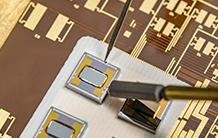Capturing light at the quantum noise limit
In astronomy and quantum optics, the ability to detect light photon-by-photon, with extreme precision down to the quantum noise limit, is a major challenge that could open the door to significant scientific breakthroughs. Unfortunately, current detectors are limited by noise interference, which impairs measurement precision. The aim is to push back this limit by designing ultra-sensitive photodetectors able to control the avalanche effect (which occurs when a single photon triggers a cascade of electrons), and therefore ensure reliable measurements at the quantum noise limit.
Controlling the avalanche effect for precise, noiseless photodetection
The research engineering team developing a photodetection process capable of minimal-noise, ultra-precise photon counting designed mercury cadmium telluride avalanche photodiodes (MCT APDs), and developed CMOS readout circuits optimized to reduce noise. The goal is to be able to detect a single photon on a surface compatible with an imaging pixel. The key to this innovation is to control the avalanche effect, a phenomenon whereby a single photon triggers a cascade of electrons. Successfully controlling these chain reactions enables quasi-perfect amplification, considerably improving measurement sensitivity.
Revealing the invisible - A bold scientific endeavor
These detectors make it possible to capture individual photons with exceptional precision, free from noise interference. They pave the way for unprecedented advances, such as detecting exoplanets with unmatched precision, observing distant galaxies, and perfecting space exploration instruments. In the field of quantum metrology, they enhance the ability to accurately locate optical point sources, with multiple applications ranging from microscopy to astrophysics. In quantum information science, they make it easier to generate the necessary light states to demonstrate a quantum advantage, far more efficiently than has been possible to date.
Overview of Audace!, the pioneering research program At national level: - In 2024, five research organizations (CEA, CNRS, INRAE, INRIA and INSERM) were tasked with conducting research programs alongside a broad spectrum of academic partners.
- Two government agencies: the General Secretariat for Investment (SGPI) specializing in financing aspects, and the National Research Agency (ANR), which handles contracting arrangements with the various institutions.
At CEA level: - €40M budget for the Audace! program
- 10 fundamental projects selected from among 35 submitted proposals, of which 25 were auditioned
- 46 seed initiatives funded, out of a total of 157 letters of intent received
- More than 80 academic partners nationwide
"The goal is to encourage blue-sky thinking and give researchers carte blanche to explore new ideas through theoretical, experimental or instrument-focused research, with no need to seek real-world applications or provide performance guarantees" Anne-Isabelle Etienvre.

Disocover HOT avalanche photodiodes technology
|